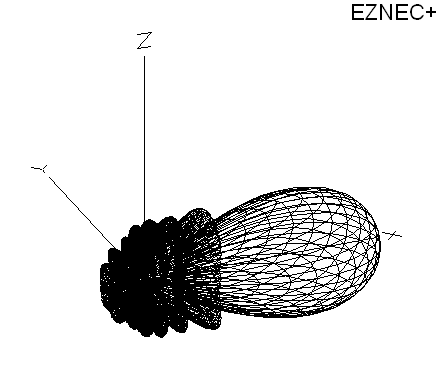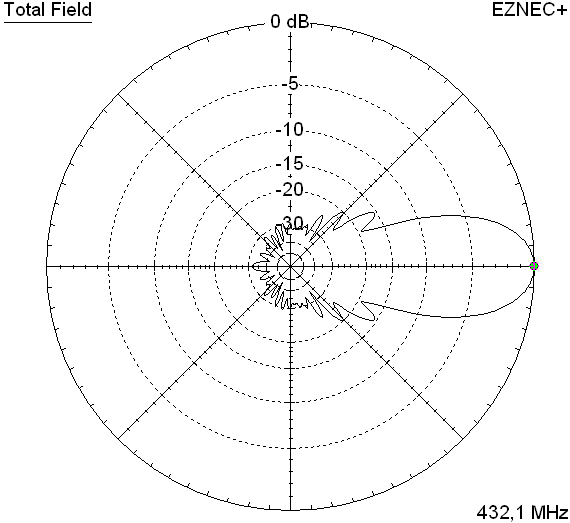
GTV RS-19m Yagi with bent DE for reception of Radio Sondes
This Yagi is designed to give Radio Sonde Hunters a very clean pattern, high performance Long Yagi with the necessary
bandwidth for monitoring the 402 - 404 MHz core part of the Radio Sonde band. It is 50 ohms direct feed, the coax cable
can be connected as is. A ferrite core added on the fed line is welcome but not essential.
This design is derived using the GTV 70-19m 432 MHz Low Noise Yagi as baseline.
Now with full building plan (Download Area) including the 'Blade DE' as introduced in Dubus 4/2014
Current distribution
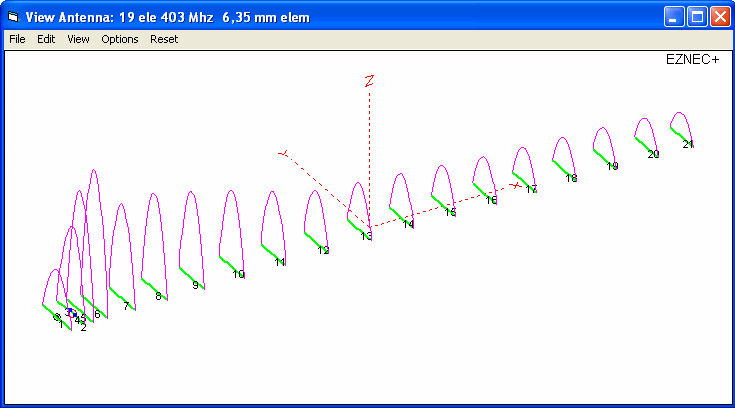
|
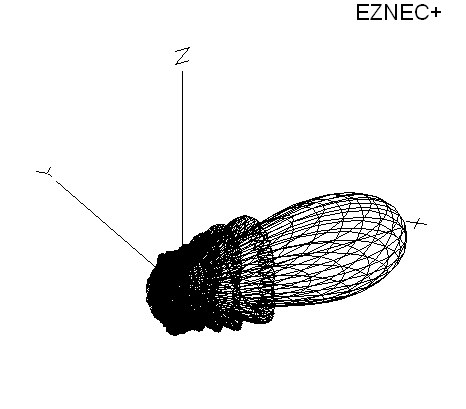
|
Performance Data
402 MHz 403 MHz 404 MHZ
Gain vs. isotr. Rad. 17.8 dBi 17.8 dBi 17.8 dBi
Gain vs. Dipole 15.5 dBD 15.6 dBD 15.6 dBD
-3 dB E-plane 25.0 deg.
-3 dB H-plane 26.0 deg.
F/B -34.6 dB -30.9 dB -28.1 dB
F/R -29.1 dB -29.1 dB -28.1 dB
Impedance 50 ohms
Mechan. Length 4413 mm
Electr. Length 5.93 λ
Stacking Dist. h-pol.
top-to-bottom 1.65 m or 5.4 ft
side-by-side 1.72 m or 5.6 ft
Geometry
Element Diameter = 1/4 in = 6.35 mm, DE = 3/8 in = 9.525 mm (Update: 8 mm ele., see down the page)
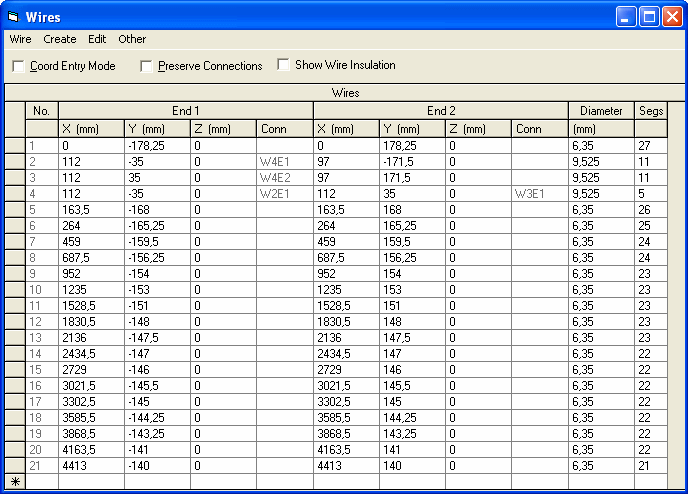
Applying the SBC factor of 1.02 mm/MHz tells us that the SBC to be added to the BC must be
(404.7 - 403.2) MHz x 1.02 mm/MHz = 1.53 mm
Boom Correction for mounting elements on boom with standard plastic insulators
Segmentation BC and Base BC (see below) must be added.

Remember - this is UHF. Cut elements very precisely. Use a large calliper gauge if you can get one. Make a mark
for final length, saw about 0,5 mm in front of the mark and grind down to final measure. Below you find BC numbers for
other boom dimension
Data for 1/4" = 6.35mm elements:
Tube dim. BC SBC BC+SBC
Boom 20 x 20 mm 7.1 mm + 1.53 mm = 8.63 mm
Boom 25 x 25 mm 10.4 mm + 1.53 mm = 11.93 mm
Boom 1 x 1 in 10.7 mm + 1.53 mm = 12.23 mm
Elements on-boom-with-standard-insualators cutting table (corr. 2014.11.27)
Pos. Full Length Full Length | Pos. Full Length Full Length Full Length
in NEC on 20x20 Boom | in NEC on 20x20 Boom on 25x25 Boom
(7.1 + 1.5 mm) | (7.1 + 1.4 mm) (10.4 + 1.4 mm)
Refl. 0.0 356.5 365.1 | 0.0 355.0 363.5 366.8
DE(b) 97.0 97-343.0 351.6 | 97.0 96.5-342.0 350.5 353.8
DE(a) 112.0 0-97 96.0 | 112.0 0-96.5 95.5 95.5
D1 163.5 336.0 344.6 | 164.0 332.5 341.0 344.3
D2 264.0 330.5 339.1 | 264.0 327.0´ 335.5 336.8
D3 459.0 319.0 327.6 | 459.0 314.5 323.0 326.3
D4 687.5 312.5 321.1 | 687.5 308.3 316.8 320.1
D5 952.0 308.0 316.6 | 952.0 304.0 312.5 315.8
D6 1235.0 306.0 314.6 | 1235.0 301.0 309.5 312.8
D7 1528.5 302.0 310.6 | 1528.5 296.3 304.8 308.1
D8 1830.5 296.0 304.6 | 1830.0 292.0 300.5 303.8
D9 2136.0 295.0 303.6 | 2136.0 290.0 298.5 301.8
D10 2434.5 294.0 302.6 | 2434.5 287.5 296.0 299.3
D11 2729.0 292.0 300.6 | 2728.5 286.5 295.0 298.3
D12 3021.5 291.0 299.6 | 3021.5 285.5 294.0 297.3
D13 3302.5 290.0 298.6 | 3302.5 283.0 291.5 294.8
D14 3585.5 288.5 297.1 | 3585.5 283.0 291.5 294.8
D15 3868.5 286.5 295.1 | 3868.5 279.0 287.5 290.8
D16 4163.5 282.0 290.6 | 4163.5 276.5 285.0 288.3
D17 4413.0 280.0 288.6 | 4413.0 272.5 281.0 284.3
ele. 1/4" ele. 1/4" ele. 1/4" | ele. 8mm ele. 8 mm ele. 8 mm ele. 8 mm
(*) Note: element lengths for Ø 8 mm fit 5/16" too
The Drivers diameter is 3/8" for 1/4" elem. and 10 mm for 8 mm elem. design.
Use EZNEC's Auto-Segmentation at 1050 MHz.
SBC 8 mm model: the 8 mm models f_res at given high segmentation is 403.1 MHz.
At conservative auto segmentation on 403 MHz it lands in at 404.5 MHz
Delta is 1.4 MHz with a factor of 1.02 mm/MHz this results in 1.448 extra mm.
Element through boom - with numbers derived using SM5BSZ's BC.exe applied
Ready to saw and drill" data for mounting elements on boom with standard insulators on 20 x 20 mm boom including a 30 mm offset from boom ends:
Insulators Ø_outer = 6 mm, Ø_inner = 4 mm press fit, booms wall thickness = 2 mm
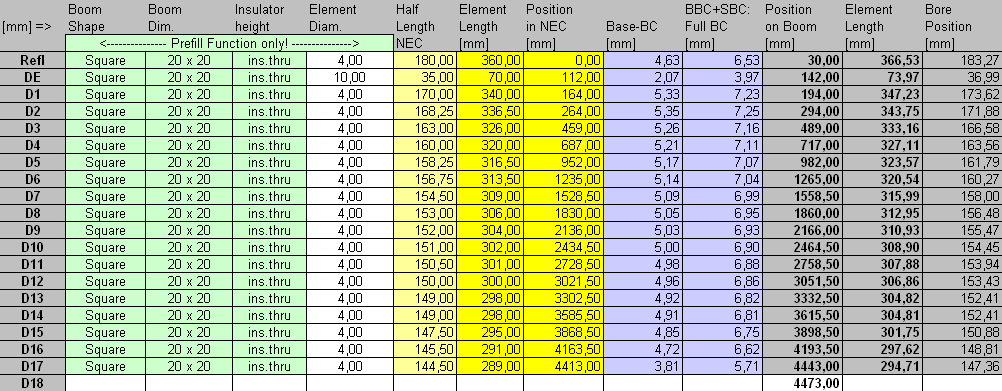
SBC 4 mm: (404.3 MHz - 403.1 MHz) x 1.02 mm/MHz = 1.224 mm plus 0.7 mm on top to compensate insulators influence
makes a total of 1.224 + 0.7 mm = 1.924 mm
The Drivers diameter is 10 mm for the 4 mm elem. design.
Use EZNEC's Auto-Segmentation at 1050 MHz.
Find a technical drawing of this Yagis boom and strut in the Download section
Advanced feeding & symmetrising
Placing a ferrite an the feeding coax as close a possible to the dipole connection will do for any reception purpose
However - here is an advanced methode:
A simple symmetrising member may be made from a 3 x 1/4 Lambda line grounded at the far side with
N-flange-bushing and an aluminium plate and ferrite added as close as possible to the DE, see below.
Pattern and VSWR Plots
Elevation and Azimuth plot at 432.1 MHz (horizontally polarised - for vertical polarisation swap views)

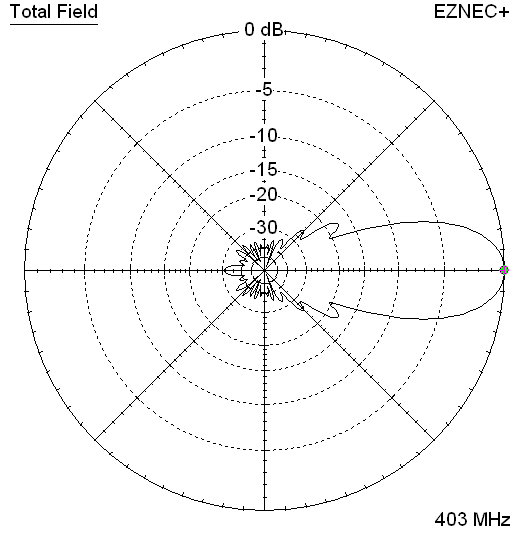
SWR plots - inner band and full band
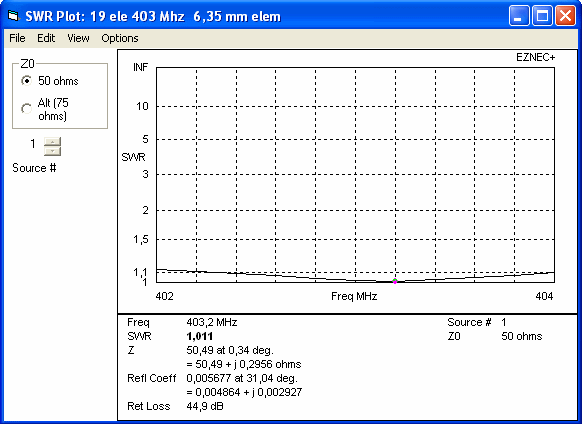

How came to visit this website?
Downloads - file update 2014-11-29
EZNEC file of this Yagi with 4 mm elements
EZNEC file of this Yagi with 1/4" elements
EZNEC file of this Yagi with 8 mm elements
Drawing of boom of this Yagi in 2 sections
Drawing of boom of this Yagi in 3 sections
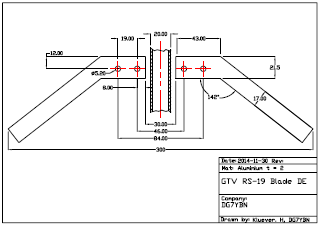
Drawing of this Yagis 'Blade' Dipole in 2 mm aluminium sheet metal
Mounting a long vertically polarised Yagi
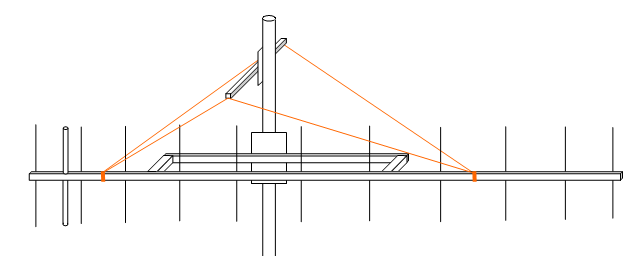
one. With help of a traverse and V-shaped kevlar, aramid or polyester guy ropes one can avoid boom sag
and add additional stability as now the supporting structure becomes 3 dimensional.
Place strut ends and guy rope fastenings as far away from elements as possible.
Bill of Materials
On-Boom-Builds
Element mounts
18 pcs: insulator 25 mm square boom (WiMo #23042.25)
18 pcs: stainless screw M3 x 40 for 25 mm boom (or 45) mm
18 pcs: M3 washers, large (Ø 9.1 mm)
18 pcs: M3 washers, ordinary (Ø 7 mm)
18 pcs: M3 self locking nut
Quarter Wave Line
1 pc: RG - 142 B/U, 400 mm (trimm to resonate at 403 MHz as 3 x 1/4 λ, approx. 373 mm)
1 pc: N-cable-flange-bushing
Boom Connnector
1 (2) pcs: Boom connector 25x25 mm boom (WiMo #23033)
2 (4) pcs: screw M6 x 35
2 (4) pcs: nut M6
4 (8) pcs: M6 washer
Other
6 pcs: Screw M3 x 8
4 pcs: M3 washers, ordinary (Ø 7 mm)
4 pcs: M3 nuts
... will be continued
Stacking
For Stacking Pattern Data and Plots on the GTV RS-19m => see GTV 70-19m
Symmetrising 50 to 50 ohms Feedline
The principle is similar to the 1/4 Lambda coax. Adding 2 x 1/4 Lambda or a half wave line does not change anything but allows
to form a gentle bow below the boom or until behind the Reflector. Follow practical construction hints on "Building a Yagi" page.
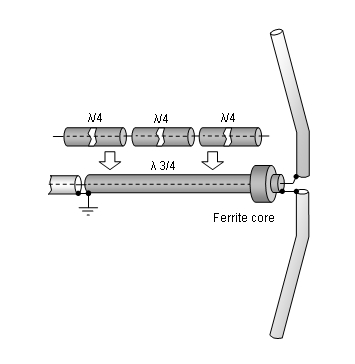

|
Attenzione!
Take care when lengthening the coax, measure the right length instead of refering to given v-factors only. A good choice may be the diam. 5 mm PTFE coax RG-142 B/U: real resonate length (403 Mhz as 3/4 Lambda) shield-shield is around 373 mm. |

|
Find more information
about getting the coax stub right on my Phasing & Matching Lines page |
73, Hartmut, DG7YBN

